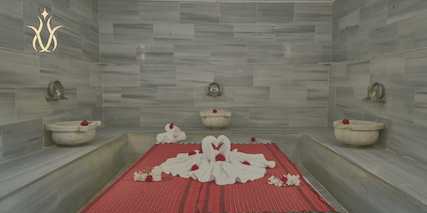The steam room, an oasis of warmth and mist, is more than just a place to unwind. It’s a sanctuary for health, offering a plethora of benefits for both mind and body wellness. As we delve into the surprising health benefits of steam rooms, we uncover its potential to enhance cardiovascular and respiratory health, promote deep relaxation and stress alleviation, revitalize skin, aid in detoxification, and support holistic muscle recovery. The steam room experience is not just about indulgence; it’s a powerful tool for maintaining and improving our overall well-being.
Key Takeaways
- Steam rooms provide a cardiovascular workout equivalent, improving blood flow and heart health, akin to the effects of low-intensity exercise.
- Inhaling steam can clear airways, improve lung function, and is especially beneficial for those with respiratory conditions like asthma or bronchitis.
- Regular steam room use promotes relaxation, reduces stress, and can lead to deeper, more restorative sleep, enhancing mental clarity and mindfulness.
- The heat and humidity of steam rooms open up pores, helping to cleanse the skin, remove impurities, and contribute to a healthier complexion and skin tone.
- Steam therapy aids in muscle recovery, alleviates chronic pain, and can improve flexibility, making it a valuable addition to any fitness or wellness routine.
Unlocking Cardiovascular and Respiratory Benefits to a Steam Room
Improved Cardiovascular Health Through Heat Therapy
Exposure to the warmth of a steam room can significantly boost your heart health. The heat promotes blood flow and improves circulation, akin to the benefits of a low-intensity workout. Regular steam room sessions may lead to a lower risk of cardiovascular diseases, providing a gentle yet effective boost to your heart’s performance.
Enhanced Respiratory Health from Steam Inhalation
The humid environment of a steam room is excellent for respiratory health. It helps soothe and open the airways, relieving conditions like sinus congestion, allergies, or bronchitis. Inhaling steam can clear the air passages, enhancing lung function and overall respiratory wellness.
Regulating Blood Pressure and Heart Rate
Steam rooms can also play a role in regulating blood pressure and heart rate. The heat induces a healthy sweat, which can help lower high blood pressure and stabilize the heart rate. This natural therapy is a valuable addition to a holistic approach to cardiovascular care.
Steam rooms offer a sanctuary for those seeking to improve their cardiovascular and respiratory health. The combination of heat and humidity provides a therapeutic environment that can enhance the body’s natural healing processes and promote overall well-being.

Deep Relaxation and Stress Alleviation Techniques
Improved Cardiovascular Health Through Heat Therapy
The warmth of a steam room can be a powerful ally in the quest for cardiovascular health. Heat therapy helps dilate blood vessels, which improves circulation and can lead to a healthier heart. Regular steam room sessions may contribute to lower blood pressure and a more robust cardiovascular system.
Enhanced Respiratory Health from Steam Inhalation
Inhaling a steam room’s warm, moist air can significantly benefit your respiratory system. It helps clear the airways, loosen phlegm, and alleviate symptoms associated with conditions like asthma and bronchitis. This natural form of therapy can enhance lung function and respiratory health.
Regulating Blood Pressure and Heart Rate
Steam rooms are not just about relaxation; they play a crucial role in regulating blood pressure and heart rate. The heat induces a mild stress response, which in turn trains your heart to cope better with stressors, potentially leading to improved heart rate variability and overall cardiovascular resilience.
Stress Reduction and Mental Clarity
Embrace the tranquillity of a steam room and let it wash away your stress. The heat promotes the release of endorphins, the body’s natural feel-good chemicals, leading to a state of mental clarity and reduced stress levels. Incorporating steam room sessions into your routine can be a transformative experience for your mental health.
Promoting Deep Sleep and Relaxation
A steam room’s soothing atmosphere is perfect for preparing your body for deep sleep. The heat helps relax muscles and promotes a sense of calmness, making it easier to fall asleep and enjoy a more restorative slumber. Add steam sauna sessions to your evening routine to experience improved sleep quality.
Creating a Calming Environment for Mindfulness
The steam room offers a unique environment where distractions fade and mindfulness thrives. It’s a sanctuary for meditation, allowing you to focus inward and practice being present. This calming space is ideal for those looking to enhance their mindfulness practice and find inner peace.
Take time for yourself in the serene embrace of a steam room. No distractions, just ultimate serenity, peace, and relaxation.
Revitalizing Skin and Detoxification Rituals
The benefit of steam rooms extends to significant skin rejuvenation. Steam opens up the pores and promotes sweating, effectively cleaning the skin and removing impurities. This process contributes to a healthier complexion, improved skin tone, and a rejuvenated appearance. Regular steam room sessions can be a plush combo for those seeking softer and clearer skin.
Detoxifying through perspiration
Another key benefit of steam rooms is detoxifying the body through perspiration. A warm environment not only opens up pores but also facilitates the removal of toxins. Proper hydration after sessions ensures that the skin remains soft, supple, and glowing.
Steam rooms for a healthier complexion
Achieving a healthier complexion and skin tone involves more than just surface treatment; it’s about nurturing the body as a whole. The ritual of steam bathing is a comprehensive wellness practice that nurtures both body and mind, offering profound health benefits and transforming daily routines into a source of healing and rejuvenation.
By elevating the act of bathing to a ritual of self-care, we not only cleanse our body but also soothe our soul, leading to a more holistic sense of well-being.
Muscle Recovery Benefits to Steam Rooms
The steam room’s warm embrace does more than just soothe the mind; it’s a haven for muscle recovery. The heat and moisture promote vasodilation, increasing blood flow to the muscles. This enhanced circulation is crucial for muscle repair, reducing soreness, and expediting the healing process post-exercise or injury.
Accelerating Muscle Recovery Post-Exercise
Post-workout, the body craves restoration. The steam room’s heat accelerates recovery by promoting relaxation and reducing inflammation. It’s a sanctuary for athletes and fitness enthusiasts to support recovery and prevent injury.
Alleviating Chronic Pain and Arthritis
For those suffering from chronic pain or arthritis, the steam room offers a respite. The warmth helps to reduce joint stiffness, enhance mobility, and provide a comforting relief from pain.
Enhancing Flexibility and Reducing Stiffness
Embracing the heat of a steam room can improve flexibility. The warm environment helps to loosen up the muscles and joints, reducing stiffness and making it easier to move and stretch.
Bringing Relaxation and Recovery Anywhere You Go
With portable solutions like the SaunaBox, relaxation and recovery are accessible no matter where life takes you. It’s revolutionizing the way we approach wellness, making it a convenient addition to any travel routine.
Incorporating Steam Room Benefits into Your Travel Routine
Travel doesn’t have to mean a pause in your wellness journey. Portable steam solutions ensure that the benefits of a steam room are never out of reach, allowing you to maintain your recovery and relaxation practices on the go.
Making Wellness Accessible and Convenient
The modern world demands modern solutions for well-being. Portable steam rooms are making wellness more accessible and convenient, fitting seamlessly into the busy lives of those who prioritize their health.

The Portable Wellness Experience
The quest for wellness doesn’t have to be confined to the walls of a spa or gym. With the advent of portable steam rooms, the benefits of heat therapy are now more accessible than ever. Bringing relaxation and recovery anywhere you go has revolutionized the way we approach self-care. Portable steam rooms are designed to be compact, easy to set up, and can be used in the comfort of your home or while travelling.
Stress Reduction and Mental Clarity
The portable steam room is a sanctuary for the mind. It provides a calming environment that helps reduce stress and promotes relaxation. The heat and steam combination soothes both the body and mind, aiding in stress relief and overall well-being. This aligns with the understanding that using a sauna improves mental health, which can also help you wind down to sleep.
Promoting Deep Sleep and Relaxation
A portable steam room can be a game-changer for those struggling with sleep. The heat helps to relax muscles and release tension, setting the stage for a deeper, more restful sleep. It’s a simple yet effective addition to any nighttime routine, ensuring that wherever you roam, you can always have access to this sleep-inducing haven.
Creating a Calming Environment for Mindfulness
Mindfulness practices are enhanced in the serene atmosphere of a steam room. The enveloping warmth allows for a deeper connection with the present moment, making it an ideal space for meditation and reflection. This portable wellness experience is not just about physical health; it’s about nurturing the mind and creating a space for tranquillity.
Bringing Relaxation and Recovery Anywhere You Go
The flexibility of a portable steam room means you can enjoy steam therapy’s benefits, whether at home or on the road. It’s a trusted companion for top performers who need to maintain their wellness routine, no matter their location.
Incorporating Steam Room Benefits into Your Travel Routine
Travel can disrupt your wellness routine, but with a portable steam room, you can maintain consistency in your self-care practices. It’s easy to incorporate into any travel routine, ensuring you can always have your recovery and relaxation time.
Making Wellness Accessible and Convenient
The portable steam room democratizes wellness, making it accessible and convenient for everyone. With various heat and duration levels to personalize your experience, it’s a versatile tool that caters to your individual needs. The ability to sweat it out at a moment’s notice, with temperatures reaching up to 130°F and 100% humidity, is a testament to the innovation behind portable wellness solutions.
The portable steam room is not just a luxury; it’s a necessity for those who prioritize their health and well-being. It’s the ultimate recovery bundle, combining the benefits of heat therapy with the convenience of portability.
Conclusion
In conclusion, the steam room offers a sanctuary for mind and body wellness, providing many health benefits that cater to our holistic well-being. From stress reduction and improved sleep to enhanced cardiovascular health and skin rejuvenation, the steam room is more than just a place to unwind—it’s a therapeutic retreat. Incorporating steam room sessions into our self-care routine can lead to better respiratory health, muscle recovery, and overall relaxation. As we’ve explored, the steam room is not merely a luxury but a powerful tool in our wellness arsenal, promoting a balanced and healthy lifestyle. So, the next time you step into the warm embrace of a steam room, remember that you’re not only cleansing your skin but also nourishing your soul and invigorating your heart.
Frequently Asked Questions
How does a steam room benefit cardiovascular health?
The heat from a steam room can help dilate blood vessels, enhancing circulation throughout the body. This increased blood flow can positively impact cardiovascular health, nutrient delivery, and waste removal, mimicking the effects of low-intensity exercise.
Can steam rooms help with respiratory issues?
Yes, steam rooms can benefit your respiratory system. The steam helps clear the airways, improve lung capacity, and enhance oxygen intake. It’s particularly beneficial for those with asthma, colds, or other respiratory conditions as it loosens phlegm and clears congestion.
How does steam room usage promote relaxation and stress relief?
Steam rooms create a calming environment that helps reduce stress and promote relaxation. The combination of heat and steam can soothe both the body and mind, aiding in stress relief and overall well-being.
In what ways does a steam room contribute to skin health?
Steam opens up the pores and promotes sweating, which can effectively cleanse the skin and remove impurities. This contributes to a healthier complexion, improved skin tone, and a rejuvenated appearance.
Can using a steam room improve sleep quality?
Incorporating steam sauna sessions into your evening routine can promote a sense of calmness, preparing the body for restful sleep. It can also help you fall asleep faster and experience deeper, more rejuvenating sleep.
Is it possible to experience the benefits of a steam room while travelling?
Yes, with portable steam room solutions, relaxation and recovery can be accessible everywhere you go. This makes wellness convenient and allows you to incorporate steam room benefits into your travel routine.
What are steam room vs sauna benefits?
Steam rooms and saunas are popular facilities at gyms and spas. Both offer health benefits through the use of heat, though they operate in distinctly different environments. Understanding the differences can help you choose the right option for your health and relaxation needs.
Steam Room
A steam room generates moist heat with high humidity levels, typically around 100% humidity, with temperatures ranging between 110°F and 114°F (43°C and 46°C). Here are some benefits:
- Respiratory Relief: The moist heat helps open up the airways, alleviating symptoms of respiratory conditions like asthma, sinusitis, and bronchitis. The steam can also help loosen phlegm and clear out mucus.
- Skin Hydration: The high humidity environment is excellent for the skin. It deeply hydrates and helps to cleanse the pores, which can lead to improved skin health and clarity.
- Muscle Relaxation: The warm, moist air helps to soothe and relax muscles, reducing tension and pain. This makes steam rooms ideal for muscle recovery after a workout.
- Detoxification: Sweating in a steam room helps flush out toxins through the skin. The steam can also boost circulation, further aiding in detoxification.
Sauna
Saunas provide dry heat with low humidity, usually around 10% to 20%, with temperatures that can range from 150°F to 195°F (65°C to 90°C). Sauna benefits include:
- Intense Sweating & Detoxification: The high temperatures cause a deep sweat, which is effective for flushing out toxins and purifying the skin.
- Improved Circulation: The heat causes blood vessels to dilate, improving circulation. This can help lower blood pressure over time and enhance blood flow to the skin and muscles.
- Pain Relief: The heat in a sauna can reduce muscle soreness, relieve arthritic pain, and reduce stiffness in the joints.
- Stress Reduction: The sauna environment is conducive to deep relaxation, which can help reduce stress levels. The heat helps to release endorphins, the body’s natural painkillers, which have a mood-lifting effect.
Choosing Between the Two
The choice between a steam room and a sauna may depend on personal preference and specific health concerns:
- For Respiratory Issues: A steam room is likely more beneficial due to its humid air.
- For Dry Skin Conditions: The steam room can provide a moisturizing effect.
- For Intense Detoxification: A sauna’s dry heat might be more effective.
- For Stress and Muscle Pain: Both options are beneficial, but saunas can provide more intense heat, which some find more relaxing or effective for pain relief.
Each facility offers a distinct experience and set of benefits, so you may want to try both to see which is more suitable for your needs. Always stay hydrated and limit your time in either environment to avoid overheating or dehydration.
What research exists on the long-term use of steam rooms and its impact on overall health?
The long-term use of steam rooms, which is similar to sauna bathing, has been associated with several health benefits, particularly for the cardiovascular and respiratory systems. Observational studies have shown that regular sauna use is associated with a reduced risk of respiratory diseases, such as chronic obstructive pulmonary disease, asthma, and pneumonia.
Additionally, sauna bathing has been linked to a reduced risk of sudden cardiac death, fatal coronary heart disease, fatal cardiovascular disease, and all-cause mortality.
The cardiovascular benefits observed include improved endothelial and microvascular function, reduced blood pressure, and arterial stiffness.
These benefits are thought to be mediated by the body’s physiological response to heat stress, which involves neuroendocrine, cardiovascular, and cytoprotective mechanisms.
Furthermore, repeated thermal therapy has been shown to improve impaired vascular endothelial function in patients with coronary risk factors, suggesting a therapeutic role for sauna treatment in patients at risk for atherosclerosis.
The dosage of sauna use, in terms of frequency and duration, appears to be an important factor, with more frequent sessions being associated with greater benefits.
Resources
Kunutsor SK, Laukkanen T, Laukkanen JA.
European Journal of Epidemiology. 2017;32(12):1107-1111.
Association Between Sauna Bathing and Fatal Cardiovascular and All-Cause Mortality Events.
Laukkanen T, Khan H, Zaccardi F, Laukkanen JA.
JAMA Internal Medicine. 2015;175(4):542-8.
Sauna Use as a Lifestyle Practice to Extend Healthspan.
Patrick RP, Johnson TL.
Experimental Gerontology. 2021;154:111509.
Heinonen I, Laukkanen JA.
American Journal of Physiology. Regulatory, Integrative and Comparative Physiology. 2018;314(5):R629-R638.
Brunt VE, Howard MJ, Francisco MA, Ely BR, Minson CT.
The Journal of Physiology. 2016;594(18):5329-42.
Pizzey FK, Smith EC, Ruediger SL, et al.
Experimental Physiology. 2021;106(6):1317-1334.
Imamura M, Biro S, Kihara T, et al.
Journal of the American College of Cardiology. 2001;38(4):1083-8.







